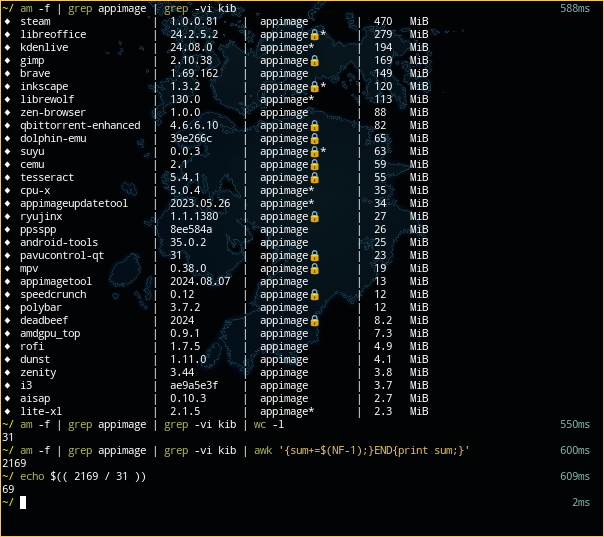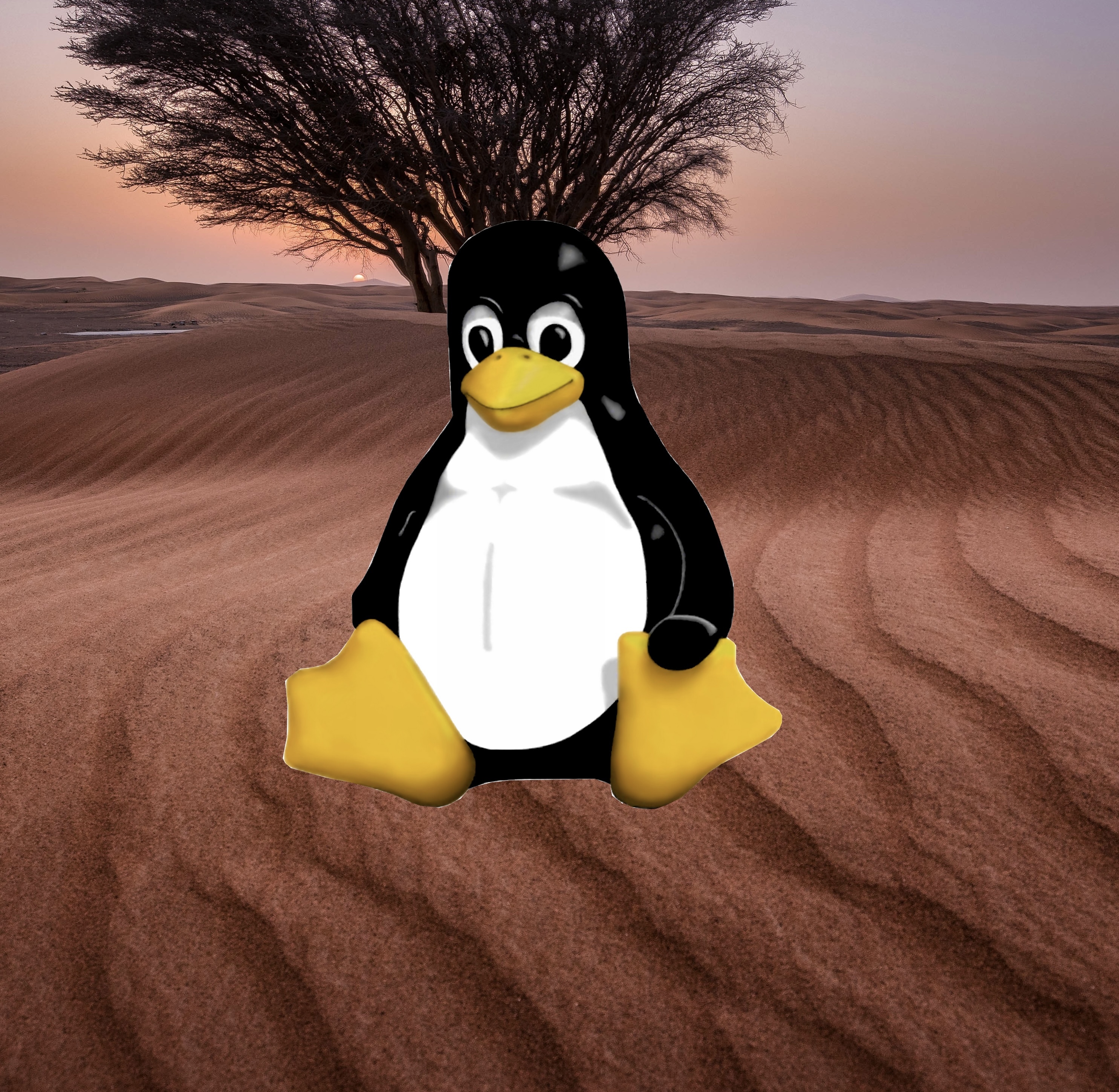How do you guys get software that is not in your distribution’s repositories?
There is no software that is not in AUR. I use arch, BTW.
But yeah, sometimes I just compile from source, if needed.
That’s exactly what the vast majority of AUR packages do already? You can also apply modifications to the compilation process if needed.
Indeed, but don’t underestimate my laziness.
My software, QuickDAV, is not in the AUR. It’s open source, and I release it only as an AppImage, because I am lazy.
I guess we should have added the word “notable”
I’m terribly sorry, you left the door wide open ;)
I’m curious, what makes AppImage a good choice for the lazy developer? Is it easier to create?
Ouch. xD
It’s super easy to create. And you distribute it on your own, so it’s basically like an installer exe on Windows. In my mind it’s one step above only offering source code.
I’m curious, what makes AppImage a good choice for the lazy developer? Is it easier to create?
The appimage is basically just
git clone->make->make install DESTDIR=/path/to/AppDir->wget appimagecreationtooland finallyappimagecreationtool /path/to/AppDirand that’s it you have your appimage.appimagecreationtool being several tools that can create the appimage from an AppDir, like linuxdeploy, linuxdeploqt, go-appimage, etc
And that on itself isn’t complex either, it if basically running ldd on the binary, then copy those libraries into the AppDir and finally run patchelf to patch the paths in the binaries and libraries, suyu uses a deploy script instead of using those tools, which I’ve recently forked and began expanding.
I don’t know how easy it is to make a flatpak or snap, but I do know the dev of zen browser hates dealing with the flatpak and iirc right now the flatpak is outdated as result.
EDIT: Also lite-xl has been making a flatpak for like 2 years and it isn’t ready yet.
There’s so much random, useful software distributed only as appimages. But not notable enough for packaging fanboys.
Rpg paper maker
Though the Linux version is now in a “do not use” state. The developer decided to just make it into a web app because it was only working on Ubuntu
i use arch based btw (I love my Manjaro and it’s AUR support) :>
Gatekeeping the word “software” here?
Here’s something not in the AUR. Tested on archClearly we need an Arch version of rule 34 and rule 35
Rule 34a: If linux software exists, it’s in the AUR. No exceptions.
Rule 35a: If linux software is not in the AUR, it will be made available in the AUR.
I don’t intend on pushing that one to the AUR. It’s not worth it.
Maybe I’ll make an AppImage at most.I don’t know any formal requirements for it being on AUR, but I just feel like this one does not fit there.
Sorry, I’ve already posted the new internet rules and they took immediate effect, I’ll have to report this incident to…the council.
Someone will put the AppImage in AUR
This is such a weird gatekeeper take
Its a joke lol, why are you so serious all the time
If you don’t compile from source, do you even Linux?
Linux From Scratch user detected
Or Slackware
Or gentoo.
Ah … yeah … totally. I would never use some filthy peasant distro like Mint. No sir! Never never ever!
AUR changed my life
Did someone’s script wipe out your tax returns?
Native package manager > Native binaries > AppImage > Flatpak.
Yes, snap isn’t even on the scale.
Not a fan of AppImages myself. For an universal format it has surprising amount of issues with different distros, in my experience. And the whole Windows style “go to a website, download the AppImage, if you want to update it, go to the web page again and download it again” is one thing I wanted to get away from. At least they don’t come with install wizards, that clicking through menus thing was a pain.
For one off stuff I run once and never need again, AppImage is alright. But not being built-in with sandboxing, repos, all that stuff, it just seems like a step back.
I ran into the same issues, mentally, when trying out AppImages for the first time - but my attitude changed once I found and started using this tool: https://github.com/ivan-hc/AM
Glad you like AM.
So it’s Scoop, but for Linux? (That’s a compliment. I love Scoop.)
App images are a very Windows way to do things. They bundle everything so they are big
They are windows, but the linux version of dll-hell across distros and distro versions makes windows dll hell look quaint.
If someone had addressed that better it would be one thing, but binary interoperability is infinitely broken, so app image is actually an improvement.
Isn’t the gnome runtime alone 2GiB? You know how many appimages that is?
Not to mention you are unlikely to only use one runtime.
Then again, loads of apps share that runtime. And if other runtimes have same stuff as that GNOME runtime, the shared parts are on your disk only once. It’s pretty smart in how it works.
Ran out of space on a 30GB partition when trying around 10 smallish programs as flatpaks. Runtimes are shared in theory but not in practice.
If you allocate 30 GB for / that seems pretty low these days for a desktop system. If you don’t have much space, it’s always best to go with regular repository packages
Here someone had 163 flatpaks and it used 8,7GB in runtimes. So I’m guessing the 30GB number is for whole of /.
I just checked out mine, I have 34 apps and runtimes use 3,1GB
Runtimes are shared in theory but not in practice.
I think three runtimes (newest freedesktop, KDE and GNOME) cover 90% of my flatpaks. Then there’s programs that use some EOL’d runtime and never get updated, which sucks
It was on a phone, and 25 GB was Flatpak
I tested installing some web browers, kdenlive, yuzu and libreoffice and without knowing I ended up with 3 different runtimes and the total storage usage (with deduplication) was 4.79 GIB.
Meanwhile with 33 appimages that I have (which includes same flatpak apps I mentioned) are using 2.2 GiB.
It doesn’t matter if they share if in the end they end up using several times more storage than the appimage equivalent.
You should test it out with those 33 installed as flatpak. If you end up with 4.7GB for runtimes, that’s basically nothing these days as far as storage goes for that amount of programs. More you have, more you benefit from shared runtimes. I doubt it’ll be less than AppImages but it’s usually the starting runtime space use that shocks people.
Here someone tested it with 163 flatpaks and the runtimes used 8.7GB. With the top 5 most used runtimes covering 128 of those flatpaks.
https://blogs.gnome.org/wjjt/2021/11/24/on-flatpak-disk-usage-and-deduplication/
I just checked out mine, I have 34 apps and runtimes use 3,1GB
It doesn’t matter if they share if in the end they end up using several times more storage than the appimage equivalent.
Well we are talking about two gigs, after all. Unless you’re using an embedded system, it’s not a much of a concern if you ask me. But it is more, true
. If you end up with 4.7GB for runtimes, that’s basically nothing these days
Yes but that wasn’t the original comment I replied to was about.
163 flatpaks and the runtimes used 8.7GB
163 flatpaks using 8.7 GiB means that the average flatpak is using 54.6 MiB.
That’s good the other time I got this linked: https://tesk.page/2023/06/04/response-to-developers-are-lazy-thus-flatpak/#but-flatpaks-are-easier-for-end-users
Which is no good as in that example there was 173 flatpaks using 27.66 GiB, average 160 MiB, while in your case the average flatpak is using 91 MiB.
This is what I have with appimages:

In this case the average appimage is using 69 MiB, though there is one outliner which is the Steam appimage that I have there (470 MiB) which is an entire conty container with its own video drivers and everything, without it the average would be 56 MiB.
I know this doesn’t matter these days but once again that wasn’t what the original comment was about.
Well we are talking about two gigs, after all. Unless you’re using an embedded system, it’s not a much of a concern if you ask me. But it is more, true
Thanks for the link showing an average flatpak using 54 MiB though, didn’t think it was possible lol.
WAIT I just took a deeper look at the link, isn’t that guy just showing the runtimes without the applications using 8.7 GiB?
Yes but that wasn’t the original comment I replied to was about.
I know this doesn’t matter these days but once again that wasn’t what the original comment was about.
I agree, it was just about the size differences. I just think it’s good to bring up since there’s many confused about the flatpak size use. Often people might want to install some small app and they’re hit with gigs of stuff and come off thinking that’s the same for every app, which would be insane of course.
WAIT I just took a deeper look at the link, isn’t that guy just showing the runtimes without the applications using 8.7 GiB?
Yes it’s specifically comparing runtimes. Same for my number, I was calculating how much the runtimes used.
I’m a technically savvy but new to Linux user who installed Mint as my primary OS about a month ago. So far I’ve used Flatpaks and AppImages without any issue and haven’t come across snaps. Would you explain the differences and why I would care about one over another?
At the end of the day, they’re just different ways of reaching the same goal: universal packages for Linux. I personally use them interchangeably depending on the application and use case.
There are some packages that definitely work better and are intended to be used and installed via your native package manager (if they rely on system libraries and whatnot). But using either a Flatpak or AppImage results in the same experience - in my experience. It’s a personal preference.
IMO flatpaks are the future of installing linux apps. The comment you replied to lives in the past. System package manager should be for system binaries, not for applications.
But I like my applications years out of date and I think its good that every distro has to spend manhours on packaging it individually.
lmao you joke but half this thread is exactly that opinion
I see the appeal for the package manager for a lot of things, but space got so incredibly cheap and fast that duplication is way less of a deal than the effort to make stuff work the traditional way. But im not a real linux user. I don’t like tinkering, I want to download something and it works. And the amazing thing is we can have both. If people like spending time to package something be my guest.
The funniest interaction I had recently. I downloaded a program that isn’t in my package manager or had any sort of flatpack/appimage so I downloaded it as a deb and it didn’t run because of some dependency. So I could clone the git and build it from source which might have worked, but I was too lazy to. So I just downloaded the windows exe and ran it through wine, which worked flawlessly.
I don’t like tinkering, I want to download something and it works.
And this is what’s keeping Linux at bay. Normies are that to the extreme. They want something that is as simple and resilient as possible, they couldn’t care less about the dependencies or even know what they are. They want
a programan app and just install it from an “app store” if possible.you are a real linux user don’t let some neckbeard tell you otherwise :P
And the last three aren’t even an option in the enterprise unless your CTO is 24.
Why not just stick to what we’ve always been doing?
- wget something.tar.gz
- tar something.tar.gz
- man tar
- tar xzf something.tar.gz
- cd something
- ls -al
- ./config.sh
- chmod +x config.sh
- ./config.sh
- make config
- Try to figure out where to get some obscure dependency, with the right version number. Discover that the last depency was hosted on the dev’s website that the dev self-hosted when it went belly up 5 years ago. Finally find the lib on some weird site with a TLD you could have sworn wasn’t even in latin characters.
- make config
- make
- Go for coffee
- make install
- SU root
- make install
I much prefer our modern package format solutions:
- sudo apt install something
- open
- wtf this is like 6 months old
- find a PPA hosted by someone claiming to have packaged the new version
- search how to install PPAs
- sudo apt <I forgot>
- install app finally
- wtf it’s 2 months old and full of bugs
- repo tells me to report to original developer
- report bugs
- mfw original dev breaks my kneecaps for reporting a bug in out of date versions packed with weird dependency constraints they can’t recreate
We should normalize programs that don’t use such exotic and impossible libraries that you have to do anything besides type “make” and “make install” for it to work.
In theory it’s a no brainer. In practice not so much.
in the end we end up using containers afaict
deleted by creator
I’m currently on a atomic distro, so how I get my software from favorite to least favorite is this:
- Flatpak
- Appimage
- Fedora distrobox
- rpm-ostree
Have you met nix?
Nix is cool but also incredibly painful
I use nix package manager on fedora silverblue. It’s awesome.
Awesomely painful
Why is it painful for you?
It just is overly complex. Nix has its own environment instead of just being a regular package manager.
os-tree is slow as molasses
As it should be, don’t do that.
Doctor, when I do this it hurts…
Also, you’re creating a disk image…
It is. I also wonder if there was a model that accomplishes the same thing but with less image copying.
Like, make snapshots every day, but manual installs are not snapshotted but still tracked with ostree. So you can revert them, display them transparently etc.
finally, somebody in this thread who doesn’t live in the past.
System package manager is for system binaries. Not for applications.
Native repos > AUR > compile from source > Flatpak
Mine is
AppImage > Native repos > AUR > Manually compiling from source > Finding an alternative
I don’t like installing software that doesn’t need to be installed, thus I like AppImage. Pretty portable. That also applies to compiling from source. Yes, my home directory is a mess.
- Compile from source
- Find alternative
- Deploy in VM/Docker
If I wanted snap, flatpak or appimages, I would use windows. Shared dependencies or death.
Shared dependencies or death
Docker🤔
I don’t like middle grounds in my packages, what can I say.
Docker containers are treated as immutable and disposable to me, like a boot CD, for each, I write a shell script to generate both a .conf if needed, a docker-compose.yml and run the container.
They’re plug’n’play separate parts to the rest of the OS, while packages are about integrating nicely with the rest of the OS, in a non-snowflakey, non-disruptive manner.
I also hate .conf.d folders and always deleted them. One program, one .conf.
Flatpaks and snaps both have shared dependencies, just at a less granular level than debs. OCI images and VMs are pretty much the extreme opposite of shared dependencies.
But snaps do have shared dependencies to a degree. Also, do you use gentoo?
No, that’s not what is meant by shared dependencies, and I don’t use Gentoo, I use Debian.
cant we just have .deb?
On arch?
If you look at some aur packages, it’s probably deb…
we got tar.zst
And windows has .zip? That’s not the same…
i mean arch linux deb version is tar.zst no joke
I was going be a smart ass and make the “I use Arch joke”… But if you can use .debs on Arch, that’s kind of neat.
The issue is with pushing updates. Eget is nice, but it doesn’t push updates.
Appimages are crap too, but at least there is progress with AppMan, repos and that sandboxing solution.
Snaps are only sandboxed with Apparmor and snapd only allows a single repo (which contained malware multiple times) so get the hell off my lawn XD
Just use flatpak. It runs and installs local but still has the benefits of a package manager
Yup.
I hate fucking snap. It might be enough to make me switch distros if Ubuntu keeps up with it (which I am sure they intend to).
The continual “you have new snaps” or whatever it was message every time I’m just trying to have a web browser open made me eventually figure out how to install firefox for real on all of my computers.
EDIT: I think you may have convinced me to try out Debian on my next OS installation.
The Firefox snap was the reason I left Ubuntu. (Or, the last straw, at least.) Fedora has been wonderful.
Try debian, they improved so much over the past decade, they’re a better Ubuntu than Ubuntu now without any bullshit.
What do you mean “improved”? Ubuntu is based on Debian.
It used to be really outdated and missing new applications, with a kernel 1 major version behind.
All that is fixed, they even have good support for new architectures like riscv on par with Ubuntu.
They’ve been doing snaps for a few years already so it already seems like they’re keeping up with this bullshit (in fact they’re putting more and more stuff there) It’s already the reason people stopped recommending Ubuntu to new users and instead go for Mint or Pop!OS
Make a script to extract it to /opt/local and make a symlink.
You’ll end up using it so much and it’s an easier upgrade on your terms.
curl
|sudo bash
very smart much secure
But it gets the job done, chaotic good
I don’t remember what program it was, the dev explained it wasn’t available as flatpak because flatpaks are unsafe or something. Then the installation guide went “well anyway here’s curl | sudo bash.” Like, lmao. Talk about bad security practices.
Download the sources and build it, like Kernighan & Richie intended.
sounds like a modern approach
AUR. If it doesn’t exist on AUR (very unlikely, but happens sometimes), I make a package for it.
On non-arch distros, I often use LURE.
How safe is LURE?
I only use my own installer scripts with LURE, so I’m not sure about the safety of the publicly available repos. But the project itself seems to be pretty solid and reliable.
as it should be, nobody likes proprietary vendor-locked formats that get shoved down your throat
Wow a reference to those Mac Vs PC ads from like 15 years ago
They stopped that ad campaign about 15 years ago, and they started it closer to 20 years ago.
I am fairly certain the original version of this meme has red shirt saying Linux and getting beat up
















